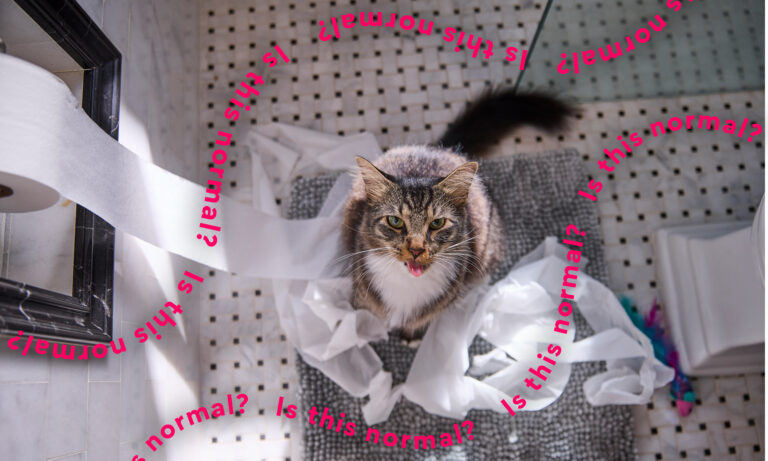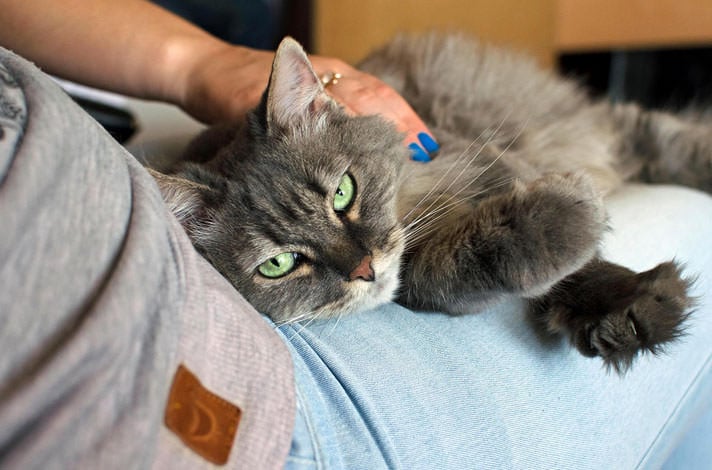Q:My cat doesn’t like it when I touch his belly. Why does my cat hate belly rubs? Is this normal?
A: Yes, it’s totally normal for a cat to hate belly rubs. You may not like being touched in certain places, and your cat doesn’t either.
Go ahead and admit it: Every time your cat rolls onto their back, you’re tempted to rub their soft, fluffy belly. But—go ahead and admit it—every time you put your hand near their stomach, they turn your open hand into their own five-fingered scratching post. So what gives?
Cats each have their own unique personalities and while some of them may enjoy snuggling beside you, sleeping in your bed, and letting you pet the full length of their furry little body, others may not be into any of that.
“Cats have different preferences, just as people do,” says the excellently named Florida-based cat behavior consultant Jennifer Catpurr. “Additionally, if they didn't have their bellies rubbed as kittens, it can be difficult for them to accept these rubs as adults.”
Lillian Ciardelli, an associate certified applied animal behaviorist at Behave Atlanta in Georgia, says that she hasn’t met too many cats who enjoy a belly rub. “Cats generally prefer pets on their heads, usually on their chin, cheeks or between their ears,” she says.
But when they show their floofy bellies to us, surely that’s an invitation to pet them, right? Actually, no.
“More likely, the cat is relaxing or stretching—not asking to be touched,” Ciardelli says. “The stomach is a sensitive area.” (She also warns that when a cat is on their back, they’re “pointy sides up,” which means that they can bite or scratch if they’re uncomfortable or feel threatened. “It’s generally not a safe place for human hands,” she says.)

Regardless of where you’re touching your cat, Ciardelli recommends going slowly, taking breaks and keeping an eye on your cat’s body language to ensure that they’re still receptive to petting. (Dilated pupils, for example, is not a good sign!) “It can become overstimulating quickly, so it’s best to make sure your cat is still comfortable,” she explains.
If your cat is hesitant about being touched, Catpurr says that positive reinforcement can be used to make your feline friend more comfortable with having your hands on them. “This entails rewarding your cat with every belly touch. Usually the reward is a favorite treat, but it can also be something else the cat loves that can be given quickly,” she explains. “The process begins with a quick belly touch, followed by an immediate reward.” Based on your cat’s comfort level, that might mean that you only give them “a couple of quick touches” on the stomach every day.
“Once your cat starts associating a belly touch with a reward, he should start looking forward to them,” she adds. “This technique extends to other body parts as well, and can be especially helpful getting your cat to accept nail trims or even a full-body exam at the vet.”
For some cats, being petted anywhere just isn’t their thing. Before you clench your fists and yell to the heavens "Why won't you let me love you," try one of these other ways to engage with your cats, as recommended by our experts:
- Playtime: Pick up the wand toy and get to playing. It not only boosts a cat’s happiness, Catpurr says, but it's also a great bonding experience.
- Slow Blinks: Did you know that one of the ways cats say I love you is by slowly blinking at you? Send some slow blinks their way, while slowly turning your head away, to say ILYSM. “This is non-threatening and reassuring to a cat, and they will often return the slow blink back to you,” Catpurr says.
- Brush Their Fur: Some cats love a good grooming sesh. A soft slicker brush is a good basic cat grooming tool. Get more at-home grooming tips here.
- Treats: If your cat loves to eat (and what cat doesn't?), a special treat could be just the thing to get them purring.
- Give Them a Place to Perch: A cat tree or a cat shelf is ideal for cats who enjoy being in your presence but prefer to keep their distance.
The goal, Ciardelli says, is to find out what your cat likes and go from there. And both behaviorists recommend learning what’s “normal” for your cat, so that if their behavior abruptly changes, you’ll know that something might be up.
“If your cat previously liked belly rubs and suddenly darts away or shows aggression [when you try to touch them], there might be something going on,” Catpurr says. If your cat’s behavior or personal preferences suddenly change, it could be worth a call to your vet.
“Another great tip is to let your cat initiate contact,” Ciardelli recommends. “If they come over to you and rub against you, that’s a good sign—but still probably not a request for belly rubs.”
Share:









